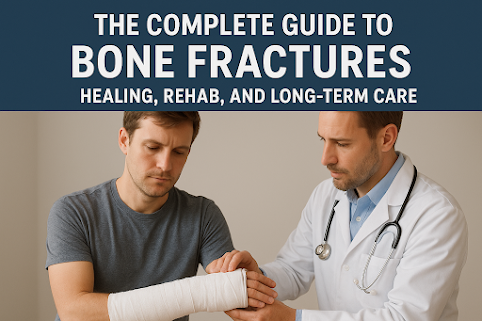Bone fractures can happen to anyone—whether from an accident, sports injury, or a fall. Understanding the types of bone fractures, how they heal, and what steps to take during recovery can make a big difference in your long-term health.
What is a Bone Fracture?
A bone fracture occurs when a bone breaks partially or completely due to excessive force. Fractures can range from minor cracks to complex breaks requiring surgery. Early diagnosis ensures faster recovery and prevents complications.
Common Types of Bone Fractures
Different types of fractures require different treatment approaches. Here are the most common ones:
- Simple fracture – Clean break without piercing the skin.
- Compound fracture – Bone breaks through the skin, needing immediate care.
- Comminuted fracture – Bone shatters into multiple fragments.
- Greenstick fracture – Incomplete break, common in children.
- Stress fracture – Tiny cracks caused by repetitive strain or overuse.
Causes and Risk Factors
Understanding the causes helps in prevention.
- Trauma or injury from accidents or falls
- Osteoporosis weakening bones
- Sports injuries and repetitive motion
- Nutritional deficiencies in calcium and vitamin D
- Age-related degeneration
Symptoms of a Bone Fracture
Early recognition is vital for effective orthopedic treatment. Look for:
- Sudden pain and swelling
- Visible deformity or bruising
- Difficulty moving the affected area
- Grinding or snapping sound during injury
Diagnosis and Treatment
Doctors use X-rays or MRI scans to confirm the break. Treatment options may include:
- Casting or splinting for stabilization
- Traction therapy to align bones
- Surgical fixation with plates or screws for complex cases
- Pain management through medication and rest
Bone Fracture Healing Process
Healing depends on age, nutrition, and severity. Typically, it happens in three stages:
- Inflammation phase – Blood clots form at the injury site.
- Repair phase – Soft callus replaces the clot.
- Remodeling phase – Bone regains original shape and strength.
Rehabilitation and Physiotherapy
Once the bone starts healing, physical therapy becomes essential.
Rehabilitation helps:
- Regain muscle strength
- Improve joint flexibility
- Prevent stiffness and re-injury
- Enhance functional recovery through exercises
Long-Term Care and Prevention
After healing, long-term care supports bone health.
- Maintain a balanced diet rich in calcium and vitamin D
- Include weight-bearing exercises
- Avoid smoking and excessive alcohol
- Schedule regular bone density tests for prevention
When to See an Orthopedic Specialist
Seek expert help if you experience persistent pain, delayed healing, or recurrent fractures. Early consultation with a bone fracture specialist ensures better recovery outcomes.
Conclusion
Bone fractures can be challenging, but with the right care, recovery is possible. Proper treatment, nutrition, and rehab can restore full strength and mobility.
Consult our Dr. Abhishek Barli Orthocare for expert bone fracture treatment and personalized orthopedic care.

